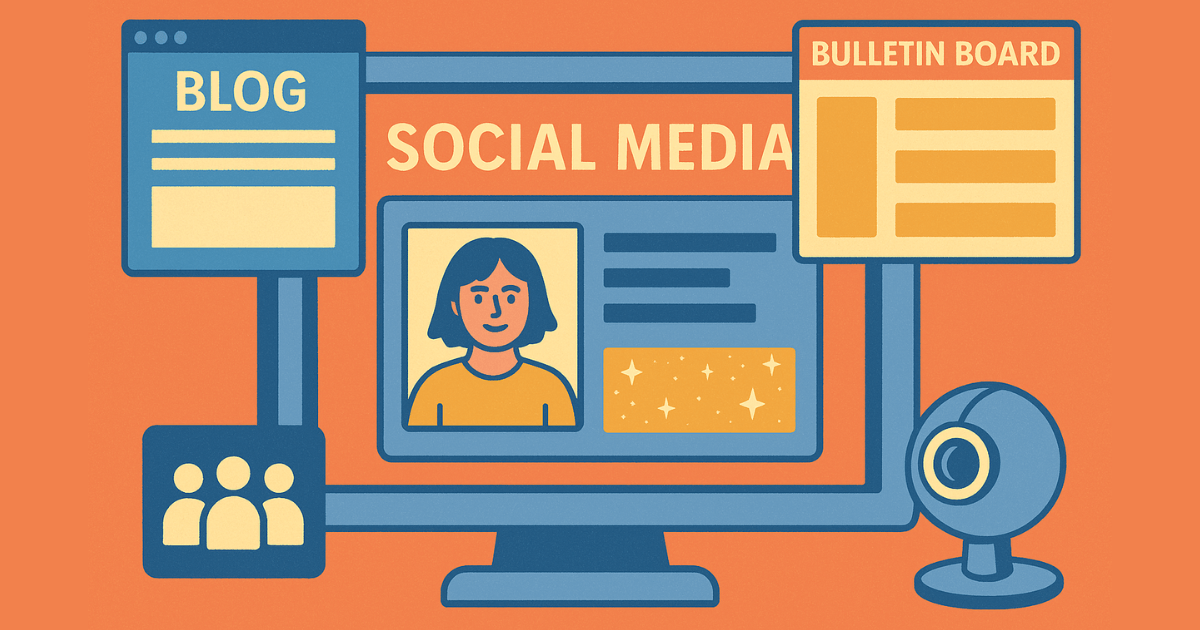Before the days of Instagram reels and TikTok dances, the internet had a different vibe. The early 2000s social media era was raw, personal, and honestly kind of chaotic—in the best way possible. It was a time when MySpace ruled the scene, glittery profile pages were a form of self-expression, and everyone had a blog or a bulletin board to shout into the void.
The early 2000s social media landscape wasn’t about followers or likes—it was about connecting with friends, customizing your profile to show off your mood, and maybe uploading a blurry webcam selfie. It felt more human, more creative, and way less commercial.
In this post, we’ll explore what made early platforms like Friendster, Xanga, and MySpace so special—and how they shaped the digital world we know today.
What Was Early 2000s Social Media All About?
Early 2000s social media was a strange mix of awkward charm and tech simplicity. It wasn’t polished, and that was part of its magic. People logged onto desktop computers, waited for dial-up to connect, and jumped into a world where creativity trumped algorithms.
Unlike today, where social media is all about reach and engagement, early platforms were focused more on personal expression. Users had full control over their profiles. You could edit your background colors, embed music, and use blinking fonts—it was wild. HTML and CSS were tools in the hands of teens and twenty-somethings who just wanted their page to look cool.
Mobile social media wasn’t a thing yet. Everything happened on computers, usually in the family living room. This meant that online time was limited, and every second online felt more meaningful. Early 2000s social media was about being seen, not going viral.
The Pioneers – Platforms That Started It All
The early 2000s saw a surge of platforms trying to connect people digitally. Each had its moment in the sun, and each shaped what we know as social media today.
Friendster was one of the first big names. Launched in 2002, it let users create profiles and connect through mutual friends. It was simple but revolutionary. Unfortunately, it couldn’t handle its fast growth and faded quickly.
Then came MySpace. It took things to a whole new level. People could completely customize their profiles, share their favorite songs, and build a “Top 8” list of friends. Bands, bloggers, and everyday users all flocked to the site.
Hi5, Orkut, and Bebo also entered the scene. These platforms gained popularity in different parts of the world. Hi5 became a big hit in Latin America and Southeast Asia. Orkut, created by a Google engineer, dominated in Brazil and India.
Meanwhile, Xanga and LiveJournal catered to those who wanted more than just profiles—they wanted to write. These sites blended blogging with social networking and let users share long-form content, poetry, or just daily thoughts.
Internet Culture in the Early 2000s
This was the age of glitter graphics, low-res selfies, and profile songs. Personalization was everything. If your page didn’t autoplay a Dashboard Confessional track, were you even online?
People used screen names like “punkprincess92” or “xXSk8rBoiXx” and filled their bios with quiz results, random facts, and inside jokes. It was messy but felt personal.
Forums and message boards were also a huge part of the social experience. Communities formed around shared interests, whether it was anime, punk rock, or computer coding. Platforms like Gaia Online and phpBB hosted tight-knit groups that talked about everything.
Unlike today’s polished influencer content, early 2000s social media was unfiltered and genuine. There were no brands chasing you around the web. You went online to express yourself, not to build a personal brand.
Rise of Facebook and the Shift in Social Media
In 2004, a new player entered the scene: Facebook. At first, it was exclusive to college students, and that exclusivity made it appealing. Unlike MySpace, Facebook had a clean design. No glitter, no music, just status updates and a structured profile.
This marked a shift in how people interacted online. Real names became the standard. Personal branding slowly replaced anonymous fun. Facebook’s success was largely due to its simplicity and the fact that it appealed to older users too.
As Facebook grew, MySpace started to decline. The cluttered design, buggy features, and lack of innovation couldn’t compete. Other platforms couldn’t keep up either. By the end of the decade, Facebook was the dominant force in social media.
How Early 2000s Social Media Shaped Today’s Platforms
Believe it or not, many features we now take for granted started back in the early 2000s. Customization, for example, laid the foundation for what we now call “personal branding.”
Blog-style posts on platforms like LiveJournal evolved into the micro-blogging formats of Twitter and Tumblr. Friend lists turned into followers. Embedded profile music? That spirit lives on in Spotify playlists and TikTok sound trends.
Even today’s idea of “sharing a moment” comes from those raw, oversharing blog posts or photo dumps. Early 2000s social media gave users the freedom to be weird, creative, and real—qualities that are now resurfacing on newer platforms like BeReal.
Why People Still Miss the Early 2000s Web
There’s a certain nostalgia for how the internet felt back then. It was slower, yes, but it felt more intimate. Social media was about connection, not content strategy.
People miss the ability to fully personalize a space. Your profile was a canvas, not a template. You learned basic coding just to stand out.
There was no algorithm telling you what to see. You visited your friends’ pages manually. That effort made the experience feel more meaningful. It wasn’t perfect, but it was ours.
Lessons from Early 2000s Social Media
Looking back, it’s clear that early platforms gave users a level of creative freedom that most modern networks don’t allow. Sure, things were a bit chaotic, but people had fun.
The main takeaway? People crave authenticity. Platforms that let users be themselves tend to build more loyal communities.
Another lesson is that growth without innovation can lead to failure. Many early platforms didn’t evolve, and that opened the door for Facebook and others to take over.
And maybe the biggest lesson: simplicity works. A clutter-free, user-focused platform wins in the long run.
Forgotten Platforms Worth Remembering
Some sites didn’t last long but left a mark. Multiply was like a mix of blogging and photo sharing. Tagged leaned into meeting new people. MSN Spaces was part of the Microsoft ecosystem but never took off like others.
ICQ and AIM were more about messaging than profiles, but they were a core part of how people socialized online. These platforms may be gone, but they shaped how we communicate today.
Final Thoughts on Early 2000s Social Media
Early 2000s social media was wild, unfiltered, and incredibly personal. It was a digital playground full of glitter, HTML, and genuine connection. We didn’t know it back then, but we were laying the foundation for everything social media has become.
Sure, the tech has changed. Everything’s faster, sleeker, and more commercial now. But the spirit of those early platforms still lingers—in every blog post, every custom playlist, and every nostalgic scroll through old screenshots.
Maybe we can’t go back, but we can appreciate what it was—and maybe learn to bring a little bit of that weird, wonderful energy into today’s digital world.

Hi, I’m Shafy Ali – a curious mind and passionate writer at Celiac Magazine. I cover a little bit of everything, from everyday tips and how-tos to deeper dives into topics that spark conversation. I enjoy turning research into readable, relatable content that informs and inspires. Whatever the subject, I aim to keep it clear, engaging, and genuinely useful.

